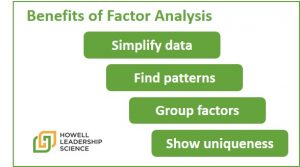
In this article, I’ll share an easy-to-understand definition of factor analysis and provide some examples of the use of it in research.
Factor analysis is a research tool used in data mining, artificial intelligence, marketing, finance, social sciences research and other areas. Coming from an Industrial/ Organizational background, my primary focus is on use of factor analysis for psychological and workplace research.
Scientific definition of factor analysis
The Wikipedia.com definition of factor analysis starts off this way: “Factor analysis is a statistical method used to describe variability among observed, correlated variables in terms of a potentially lower number of unobserved variables called factors. For example, it is possible that variations in six observed variables mainly reflect the variations in two unobserved (underlying) variables. ”
And the Wikipedia page goes on to cover a lot of Greek letters in complex formulas and discuss concepts like ‘unobserved stochastic error terms”.
For an easier to understand discussion of factor analysis, check out this page at Statistics How To. They share some good examples and definitions of factor analysis and related terms, before going deep into the statistics.
Fortunately, you don’t need to understand any of that to benefit from the rest of this article. We’ll keep the discussion high level and focused on the purpose of being able to interpret research discussions on Science of Working.
Practical definition of factor analysis
A more practical definition of factor analysis is that it takes a big set of data and groups parts of the data together into smaller, related chunks. This makes the data more manageable and can help identify relationships in the data that were not obvious before.
The smaller, related chunks of data are called ‘factors’.
Two kinds – exploratory and confirmatory
Researchers use different types of factor analysis based on their hypotheses and data. If they don’t have an expected hypothesis, they can do an exploratory factor analysis on the data. This allows them to explore patterns in the data, see how it groups and what factors are formed. They explore the data.
If researchers expect the data to group into certain factors, they set their hypotheses and then do a confirmatory factor analysis. If the hypothesis was correct, the factor analysis supports the way the data is chunked into factors. They confirm (or sometimes disprove) their initial ideas.
Benefits of factor analysis

My practical, non-jargony view of factor analysis is that it does four key things:
- Simplify data – it takes a big set of data and groups it into factors. The factors are easier to interpret than the full data set.
- Find patterns – it finds patterns in the data in order to do the factor grouping. The underlying pattern (sometimes called a latent or confounding variable) might only appear after the factor analysis finds the relationships. For a research geek, it is thrilling to see the results group together in patterns – whether expected or not.
- Group factors – the output of a factor analysis is the factors. These factors can become variables themselves and can also reveal data that does not fit with any of the other factors.
- Show uniqueness – strong factors include data that is related and does not include unrelated data. This creates a pure (at least relatively pure) construct that is different from the other factors.
Research example: factor analysis and the Big 5 Personality Traits
Factor analysis plays a role in many psychology research studies from proving the key hypotheses to validating constructs used in a broader study.
A great example of the value of factor analysis is identification of the Big 5 personality traits. In an earlier article, we reviewed the definitions of the Big 5 which are: openness to experience, conscientiousness, extraversion, agreeableness and emotional stability.
I highlighted the Big 5 theory of personality, because it has strong research support. Specifically, that research support comes through factor analysis.
Different researchers over a variety of studies conducted factor analyses looking for the core components to explain personality. They found the Big 5.
In analyzing their data, the factor analysis of personality research data consistently explained the results by grouping it into the five factors. Statistically, the data would display five solid factors and each of the five proved to be different from the others.
Finding these five consistent factors across different studies provided additional evidence that the results were meaningful.
Additional examples of factor analysis
Many of the research studies highlighted on Science of Working used factor analysis. In some cases, the factor analysis provided the primary result for the research. In other cases, the researchers completed the factor analysis on one or to of the variables used in a bigger study.
Of the studies covered on this site, these included factor analysis. Check them out for more details.
Big 5 and situation strength and factor analysis methods
In their research of personality traits influencing job performance covered in “Is it me or the job? Research on personality at work“, Judge and Zapata used factor analysis to search for factors within the variable of ‘situation strength’. They found two factors: situation strength – process (which explained 47.32% of the variance) and situation strength-outcomes (which explained 28.70% of the variance).
And, of course, their research leveraged the Big 5 personality traits, so they started with work based on earlier factor analysis research that identified the Big 5.
T.A. Judge and C.P. Zapata (2015) “The person-situation debate revisited: Effect of situation strength and trait activation on the validity of the Big Five personality traits in predicting performance”, Academy of Management Journal, Vol 58, 4, 1149-1179. http://dx.doi.org/10.5465/amj.2010.0837
Factor analysis and transformational leadership
In the research covered in “The Goldilocks Theory of Transformational Leadership“, Tepper and colleagues used a confirmatory factor analysis to compare seven different combinations of factors to explain transformational leadership related to their person-environment fit perspective.
Their analyses found that a 12 factor model performed best in the factor analysis. Their 12 factor model of transformational leadership included: transformational leadership needed, transformational leadership received, postivie affect, negative affect, job satisfaction, satisfaction with supervision, organizational citizenship behaviors for the organization, organizational citizenship behaviors for the individual, challenge stress, hindrance stress, uncertainty and meaningfulness.
B.J. Tepper, N. Dimotakis, L.S. Lambert, J. Koopman, F.K. Matta, H.M. Park, W. Goo (2018) “Examining Follower Responses to Transformational Leadership From a Dynamic, Person-Environment Fit Perspective”, Academy of Management Journal, Vol 61, 4, 1343-1368.
Factor analysis and new leader transitions
As highlighted in the article “Research says – new leader transition can make or break a team“, Lam, Lee Taylor and Zhao conducted several confirmatory factor analyses to establish that their variables had were unique and distinguishable. They evaluated the mediators (new leader identification, the team’s identification with the new leaders change agenda and the team’s proactive personality) and found support for this three factor model.
They performed another confirmatory factor analysis to evaluate engagement with the change agenda, voice behavior to the change agenda and the new leaders proactive personality to determine that they are distinct factors.
W. Lam, C. Lee, M.S. Taylor, H. Zhao (2018). “Does Proactive Personality Matter in Leadership Transitions? Effects of Proactive Personality on New Leader Identification and responses to new leaders and their Change Agendas”, Academy of Management Journal, Vol 61, 1, 245-263.



